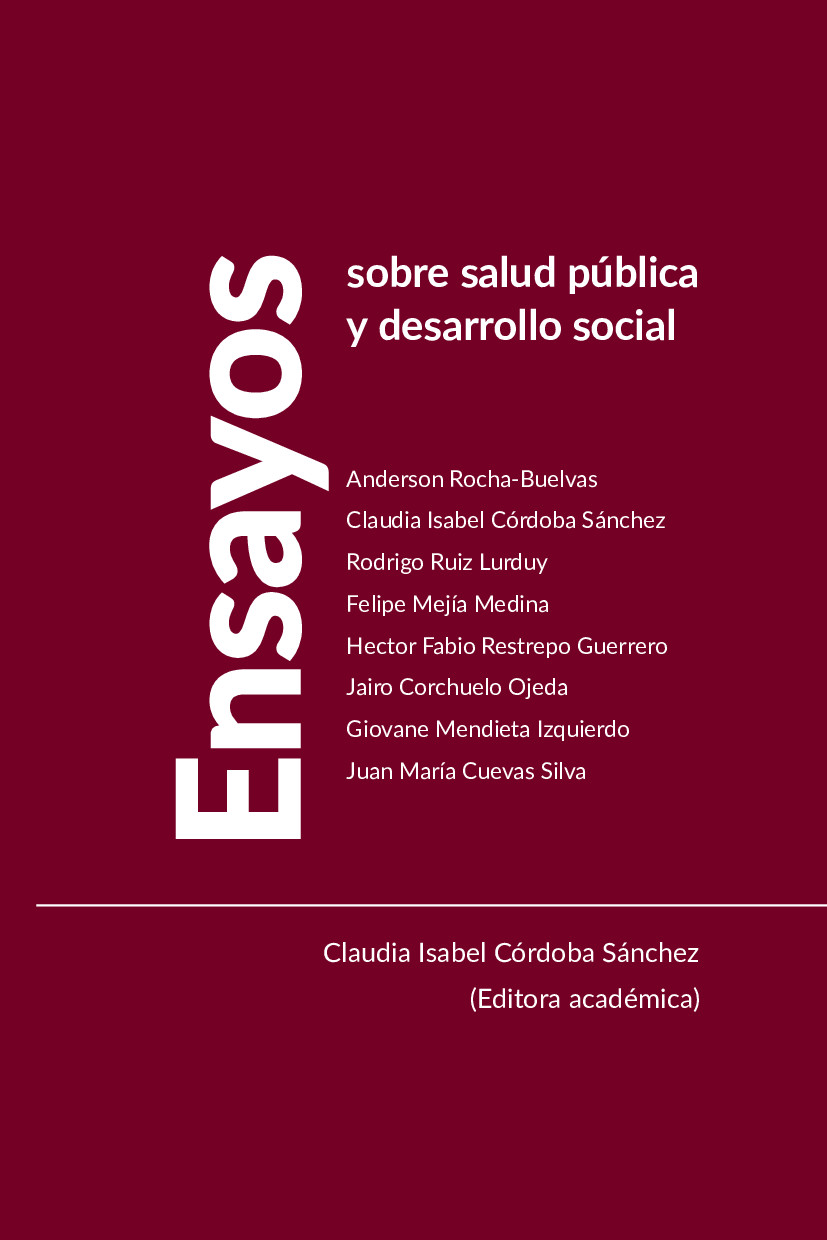Abstract
Metabolic syndrome (MetS) is a disease of high global and regional prevalence, which is often associated with complications at both cardiovascular and metabolic level, becoming into a major health risk for our population. Despite controversy about the diagnosis criteria and pathophysiology, many of these mechanisms have been sufficiently studied. The aim of this review is to summarize the proposed pathophysiological mechanisms to develop MetS, including insulin resistance as the main axis.
Licence
Authors should declare no conflicts of interest either for reasons of financing the project which is the result of the article; as well as intellectuals, academics, moral and investigative reasons.
The Journal of Andean Research is home to the ethical rules for publications issued by the COPE: http://publicationethics.org/resources/code-conduct
References
2. Edwards KL, Wan JY, Hutter CM, Fong PY, Santorico SA. Multivariate linkage scan for metabolic syndrome traits in families with type 2 diabetes. Obesity. 2011 Jun;19(6):1235- 43. http://dx.doi.org/10.1038/oby.2010.299
3. Inchiostro S, Fadini GP, de Kreutzenberg SV, Citroni N, Avogaro A. Is the metabolic syndrome a cardiovascular risk factor beyond its specific components? Journal of the American College of Cardiology. 2007 Jun 26;49(25):2465; author reply -6.
4. National Cholesterol Education Program Expert Panel on Detection E, Treatment of High Blood Cholesterol in A. Third Report of the National Cholesterol Education Program (NCEP) Expert Panel on Detection, Evaluation, and Treatment of High Blood Cholesterol in Adults (Adult Treatment Panel III) final report. Circulation. 2002 Dec 17;106(25):3143-421.
5. Ford ES, Giles WH, Dietz WH. Prevalence of the metabolic syndrome among US adults: findings from the third National Health and Nutrition Examination Survey. Jama. 2002 Jan 16;287(3):356-9. http://dx.doi.org/10.1001/jama.287.3.356
6. Marquez-Sandoval F, Macedo-Ojeda G, Viramontes-Horner D, Fernandez Ballart JD, Salas Salvado J, Vizmanos B. The prevalence of metabolic syndrome in Latin America: a systematic review. Public health nutrition. 2011 Oct;14(10):1702-13. http://dx.doi.org/10.1017/S1368980010003320
7. Manzur F. Caracterización fenotípica y metabólica del síndrome metabólico en Cartagena de Indias. Revista Colombiana de Cardiología 2008;15.
8. Lopez-Jaramillo P, Sanchez RA, Diaz M, Cobos L, Bryce A, Parra Carrillo JZ, et al. Latin American consensus on hypertension in patients with diabetes type 2 and metabolic syndrome. Journal of hypertension. 2013 Feb;31(2):223-38. http://dx.doi.org/10.1097/HJH.0b013e32835c5444
9. Yun JE, Won S, Sung J, Jee SH. Impact of metabolic syndrome independent of insulin resistance on the development of cardiovascular disease. Circulation journal : official journal of the Japanese Circulation Society. 2012;76(10):2443-8. http://dx.doi.org/10.1253/circj.CJ-12-0125
10. Scott R, Donoghoe M, Watts GF, O'Brien R, Pardy C, Taskinen MR, et al. Impact of metabolic syndrome and its components on cardiovascular disease event rates in 4900 patients with type 2 diabetes assigned to placebo in the FIELD randomised trial. Cardiovascular diabetology. 2011;10:102. http://dx.doi.org/10.1186/1475-2840-10-102
11. Reaven GM. Banting Lecture 1988. Role of insulin resistance in human disease. 1988. Nutrition. 1997 Jan;13(1):65; discussion 4, 6.
12. WHO. WHO, Surveillance. DoND. Definition, diagnosis and classification of diabetes mellitus and its complications : report of a WHO consultation. Part 1, Diagnosis and classification of diabetes mellitus. . [Report]. 1999.
13. Balkau B, Charles MA. Comment on the provisional report from the WHO consultation. European Group for the Study of Insulin Resistance (EGIR). Diabet Med. 1999 May;16(5):442-3. http://dx.doi.org/10.1046/j.1464-5491.1999.00059.x
14. Alberti KG, Zimmet P, Shaw J. The metabolic syndrome--a new worldwide definition. Lancet. 2005 Sep 24-30;366(9491):1059-62. http://dx.doi.org/10.1016/S0140-6736(05)67402-8
15. Grundy SM, Cleeman JI, Daniels SR, Donato KA, Eckel RH, Franklin BA, et al. Diagnosis and management of the metabolic syndrome: an American Heart Association/ National Heart, Lung, and Blood Institute Scientific Statement. Circulation. 2005 Oct 25;112(17):2735-52. http://dx.doi.org/10.1161/CIRCULATIONAHA.105.169404
16. Alberti KG, Eckel RH, Grundy SM, Zimmet PZ, Cleeman JI, Donato KA, et al. Harmonizing the metabolic syndrome: a joint interim statement of the International Diabetes Federation Task Force on Epidemiology and Prevention; National Heart, Lung, and Blood Institute; American Heart Association; World Heart Federation; International Atherosclerosis Society; and International Association for the Study of Obesity. Circulation. 2009 Oct 20;120(16):1640-5. http://dx.doi.org/10.1161/CIRCULATIONAHA.109.192644
17. Verhagen SN, Wassink AM, van der Graaf Y, Gorter PM, Visseren FL, Group SS. Insulin resistance increases the occurrence of new cardiovascular events in patients with manifest arterial disease without known diabetes. the SMART study. Cardiovascular diabetology. 2011;10:100. http://dx.doi.org/10.1186/1475-2840-10-100
18. Lee IT, Chiu YF, Hwu CM, He CT, Chiang FT, Lin YC, et al. Central obesity is important but not essential component of the metabolic syndrome for predicting diabetes mellitus in a hypertensive family-based cohort. Results from the Stanford Asia-pacific program for hypertension and insulin resistance (SAPPHIRe) Taiwan follow-up study. Cardiovascular diabetology. 2012;11:43. http://dx.doi.org/10.1186/1475-2840-11-43
19. Zachurzok-Buczynska A, Klimek K, FirekPedras M, Malecka-Tendera E. Are metabolic syndrome and its components in obese children influenced by the overweight status or the insulin resistance? Endokrynologia Polska. 2011;62(2):102-8.
20. Abbasi F, Blasey C, Reaven GM. Cardiometabolic risk factors and obesity: does it matter whether BMI or waist circumference is the index of obesity? The American journal of clinical nutrition. 2013 Sep;98(3):637-40. http://dx.doi.org/10.3945/ajcn.112.047506
21. Lee DC, Sui X, Church TS, Lavie CJ, Jackson AS, Blair SN. Changes in fitness and fatness on the development of cardiovascular disease risk factors hypertension, metabolic syndrome, and hypercholesterolemia. Journal of the American College of Cardiology. 2012 Feb 14;59(7):665-72. http://dx.doi.org/10.1016/j.jacc.2011.11.013
22. Roosheroe AG, Setiati S, Istanti R. Insulin resistance as one of indicators for metabolic syndrome and its associated factors in Indonesian elderly. Acta medica Indonesiana. 2012 Jul;44(3):199-206.
23. Povel CM, Boer JM, Onland-Moret NC, Dolle ME, Feskens EJ, van der Schouw YT. Single nucleotide polymorphisms (SNPs) involved in insulin resistance, weight regulation, lipid metabolism and inflammation in relation to metabolic syndrome: an epidemiological study. Cardiovascular diabetology. 2012;11:133. http://dx.doi.org/10.1186/1475-2840-11-133
24. Smith JD, Borel AL, Nazare JA, Haffner SM, Balkau B, Ross R, et al. Visceral adipose tissue indicates the severity of cardiometabolic risk in patients with and without type 2 diabetes: results from the INSPIRE ME IAA study. The Journal of clinical endocrinology and metabolism. 2012 May;97(5):1517-25. http://dx.doi.org/10.1210/jc.2011-2550
25. Liu J, Fox CS, Hickson D, Bidulescu A, Carr JJ, Taylor HA. Fatty liver, abdominal visceral fat, and cardiometabolic risk factors: the Jackson Heart Study. Arteriosclerosis, thrombosis, and vascular biology. 2011 Nov;31(11):2715-22. http://dx.doi.org/10.1161/ATVBAHA.111.234062
26. Shah A, Hernandez A, Mathur D, Budoff MJ, Kanaya AM. Adipokines and body fat composition in South Asians: results of the Metabolic Syndrome and Atherosclerosis in South Asians Living in America (MASALA) study. Int J Obes (Lond). 2012 Jun;36(6):810- 6.
http://dx.doi.org/10.1038/ijo.2011.167
27. Lau CH, Muniandy S. Novel adiponectinresistin (AR) and insulin resistance (IRAR) indexes are useful integrated diagnostic biomarkers for insulin resistance, type 2 diabetes and metabolic syndrome: a case control study. Cardiovascular diabetology. 2011;10:8. http://dx.doi.org/10.1186/1475-2840-10-8
28. Bremer AA, Devaraj S, Afify A, Jialal I. Adipose tissue dysregulation in patients with metabolic syndrome. The Journal of clinical endocrinology and metabolism. 2011 Nov;96(11):E1782-8. http://dx.doi.org/10.1210/jc.2011-1577
29. Pasini E, Flati V, Paiardi S, Rizzoni D, Porteri E, Aquilani R, et al. Intracellular molecular effects of insulin resistance in patients with metabolic syndrome. Cardiovasc Diabetol. 2010;9:46. http://dx.doi.org/10.1186/1475-2840-9-46
30. Taton J, Czech A, Piatkiewicz P. Insulin as the main regulator of cellular glucose utilization--aetiological aspects of insulin resistance. Endokrynologia Polska. 2010 JulAug;61(4):388-94.
31. Cusi K, Maezono K, Osman A, Pendergrass M, Patti ME, Pratipanawatr T, et al. Insulin resistance differentially affects the PI 3-kinaseand MAP kinase-mediated signaling in human muscle. J Clin Invest. 2000 Feb;105(3):311- 20. http://dx.doi.org/10.1172/JCI7535
32. Federici M, Menghini R, Mauriello A, Hribal ML, Ferrelli F, Lauro D, et al. Insulindependent activation of endothelial nitric oxide synthase is impaired by O-linked glycosylation modification of signaling proteins in human coronary endothelial cells. Circulation. 2002 Jul 23;106(4):466-72. http://dx.doi.org/10.1161/01.CIR.0000023043.02648.51
33. Iozzo P. Viewpoints on the way to the consensus session: where does insulin resistance start? The adipose tissue. Diabetes Care. 2009 Nov;32 Suppl 2:S168-73. http://dx.doi.org/10.2337/dc09-S304
34. Randle PJ. Regulatory interactions between lipids and carbohydrates: the glucose fatty acid cycle after
35 years. Diabetes Metab Rev. 1998 Dec;14(4):263-83. 35. Sandhofer A, Kaser S, Ritsch A, Laimer M, Engl J, Paulweber B, et al. Cholesteryl ester transfer protein in metabolic syndrome. Obesity (Silver Spring). 2006 May;14(5):812- 8.
36. Scuteri A, Orru M, Morrell C, Piras MG, Taub D, Schlessinger D, et al. Independent and additive effects of cytokine patterns and the metabolic syndrome on arterial aging in the SardiNIA Study. Atherosclerosis. 2011 Apr;215(2):459-64. http://dx.doi.org/10.1016/j.atherosclerosis.2010.12.023
37. Chen SJ, Yen CH, Huang YC, Lee BJ, Hsia S, Lin PT. Relationships between inflammation, adiponectin, and oxidative stress in metabolic syndrome. PloS one. 2012;7(9):e45693. http://dx.doi.org/10.1371/journal.pone.0045693
38. de Oliveira Silva A, Tibana RA, Karnikowski MG, Funghetto SS, Prestes J. Inflammatory status in older women with and without metabolic syndrome: is there a correlation with risk factors? Clinical interventions in aging. 2013;8:361-7. http://dx.doi.org/10.2147/CIA.S39899
39. Ito Y, Daitoku H, Fukamizu A. Foxo1 increases pro-inflammatory gene expression by inducing C/EBPbeta in TNF-alpha-treated adipocytes. Biochem Biophys Res Commun. 2009 Jan 9;378(2):290-5. http://dx.doi.org/10.1016/j.bbrc.2008.11.043
40. Rask-Madsen C, Dominguez H, Ihlemann N, Hermann T, Kober L, Torp-Pedersen C. Tumor necrosis factor-alpha inhibits insulin's stimulating effect on glucose uptake and endothelium-dependent vasodilation in humans. Circulation. 2003 Oct 14;108(15):1815-21. http://dx.doi.org/10.1161/01.CIR.0000091406.72832.11
41. Gao D, Madi M, Ding C, Fok M, Steele T, Ford C, et al. Interleukin-1beta mediates macrophage-induced impairment of insulin signaling in human primary adipocytes. Am J Physiol Endocrinol Metab. 2014 Aug 1;307(3):E289-304. http://dx.doi.org/10.1152/ajpendo.00430.2013
42. Bo S, Ciccone G, Baldi I, Gambino R, Mandrile C, Durazzo M, et al. Plasma visfatin concentrations after a lifestyle intervention were directly associated with inflammatory markers. Nutr Metab Cardiovasc Dis. 2009 Jul;19(6):423-30. 43. Sun L, Hu FB, Yu Z, Li H, Liu H, Wang X, et al. Lean body mass, interleukin 18, and metabolic syndrome in apparently healthy Chinese. PloS one. 2011;6(3):e18104. http://dx.doi.org/10.1371/journal.pone.0018104
44. Dusserre E, Moulin P, Vidal H. Differences in mRNA expression of the proteins secreted by the adipocytes in human subcutaneous and visceral adipose tissues. Biochim Biophys Acta. 2000 Jan 3;1500(1):88-96. http://dx.doi.org/10.1016/S0925-4439(99)00091-5
45. Testa R, Bonfigli AR, Piantanelli L, Manfrini S, Testa I, Gregorio F. Relationship between plasminogen activator inhibitor type-1 plasma levels and the lipoprotein(a) concentrations in non-insulin-dependent diabetes mellitus. Diabetes Res Clin Pract. 1996 Jul;33(2):111-8. http://dx.doi.org/10.1016/0168-8227(96)01286-7
46. Eglit T, Lember M, Ringmets I, Rajasalu T. Gender differences in serum high-molecularweight adiponectin levels in metabolic syndrome. European journal of endocrinology / European Federation of Endocrine Societies. 2013 Mar;168(3):385-91.
47. Yamauchi T, Kamon J, Minokoshi Y, Ito Y, Waki H, Uchida S, et al. Adiponectin stimulates glucose utilization and fatty-acid oxidation by activating AMP-activated protein kinase. Nat Med. 2002 Nov;8(11):1288-95. http://dx.doi.org/10.1038/nm788
48. Yu D, Yu Z, Sun Q, Sun L, Li H, Song J, et al. Effects of body fat on the associations of high-molecular-weight adiponectin, leptin and soluble leptin receptor with metabolic syndrome in Chinese. PloS one. 2011;6(2):e16818. http://dx.doi.org/10.1371/journal.pone.0016818
49. de Souza Batista CM, Yang RZ, Lee MJ, Glynn NM, Yu DZ, Pray J, et al. Omentin plasma levels and gene expression are decreased in obesity. Diabetes. 2007 Jun;56(6):1655-61. http://dx.doi.org/10.2337/db06-1506
50. Yubero-Serrano EM, Delgado-Lista J, PenaOrihuela P, Perez-Martinez P, Fuentes F, Marin C, et al. Oxidative stress is associated with the number of components of metabolic syndrome: LIPGENE study. Experimental & molecular medicine. 2013;45:e28. http://dx.doi.org/10.1038/emm.2013.53
51. Beydoun MA, Shroff MR, Chen X, Beydoun HA, Wang Y, Zonderman AB. Serum antioxidant status is associated with metabolic syndrome among U.S. adults in recent national surveys. The Journal of nutrition. 2011 May;141(5):903-13. http://dx.doi.org/10.3945/jn.110.136580
52. Jeong SK, Kim YK, Park JW, Shin YJ, Kim DS. Impact of visceral fat on the metabolic syndrome and nonalcoholic fatty liver disease. J Korean Med Sci. 2008 Oct;23(5):789-95. http://dx.doi.org/10.3346/jkms.2008.23.5.789
53. Momesso DP, Bussade I, Lima GA, Fonseca LP, Russo LA, Kupfer R. Body composition, metabolic syndrome and insulin resistance in type 1 diabetes mellitus. Arquivos brasileiros de endocrinologia e metabologia. 2011 Apr;55(3):189-93. http://dx.doi.org/10.1590/S0004-27302011000300003
54. Kwon JH, Jang HY, Oh MJ, Rho JS, Jung JH, Yum KS, et al. Association of visceral fat and risk factors for metabolic syndrome in children and adolescents. Yonsei medical journal. 2011 Jan;52(1):39-44. http://dx.doi.org/10.3349/ymj.2011.52.1.39
55. Nakao YM, Miyawaki T, Yasuno S, Nakao K, Tanaka S, Ida M, et al. Intra-abdominal fat area is a predictor for new onset of individual components of metabolic syndrome: MEtabolic syndRome and abdominaL ObesiTy (MERLOT study). Proc Jpn Acad Ser B Phys Biol Sci. 2012;88(8):454-61. http://dx.doi.org/10.2183/pjab.88.454
56. Chang Y, Sung E, Yun KE, Jung HS, Kim CW, Kwon MJ, et al. Weight change as a predictor of incidence and remission of insulin resistance. PloS one. 2013;8(5):e63690. http://dx.doi.org/10.1371/journal.pone.0063690
57. Therkelsen KE, Pedley A, Speliotes EK, Massaro JM, Murabito J, Hoffmann U, et al. Intramuscular fat and associations with metabolic risk factors in the Framingham Heart Study. Arterioscler Thromb Vasc Biol. 2013 Apr;33(4):863-70. http://dx.doi.org/10.1161/ATVBAHA.112.301009
58. Thanassoulis G, Massaro JM, Hoffmann U, Mahabadi AA, Vasan RS, O'Donnell CJ, et al. Prevalence, distribution, and risk factor correlates of high pericardial and intrathoracic fat depots in the Framingham heart study. Circ Cardiovasc Imaging. 2010 Sep;3(5):559-66. http://dx.doi.org/10.1161/CIRCIMAGING.110.956706
59. Lee JS, Kim SH, Jun DW, Han JH, Jang EC, Park JY, et al. Clinical implications of fatty pancreas: correlations between fatty pancreas and metabolic syndrome. World J Gastroenterol. 2009 Apr 21;15(15):1869-75. http://dx.doi.org/10.3748/wjg.15.1869
60. Wang C, Wang B, He H, Li X, Wei D, Zhang J, et al. Association between insulin receptor gene polymorphism and the metabolic syndrome in Han and Yi Chinese. Asia Pacific journal of clinical nutrition. 2012;21(3):457- 63.
61. Trottier A, Battista MC, Geller DH, Moreau B, Carpentier AC, Simoneau-Roy J, et al. Adipose tissue insulin resistance in peripubertal girls with first-degree family history of polycystic ovary syndrome. Fertility and sterility. 2012 Dec;98(6):1627-34. http://dx.doi.org/10.1016/j.fertnstert.2012.08.025
62. Linares Segovia B, Gutiérrez Tinoco M, Izquierdo Arrizon A, Guizar Mendoza JM, Amador Licona N. Long-term consequences for offspring of paternal diabetes and metabolic syndrome. Experimental diabetes research. 2012;2012:684562. http://dx.doi.org/10.1155/2012/684562
63. Weng C, Yuan H, Tang X, Huang Z, Yang K, Chen W, et al. Age- and gender dependent association between components of metabolic syndrome and subclinical arterial stiffness in a Chinese population. International journal of medical sciences. 2012;9(8):730-7. http://dx.doi.org/10.7150/ijms.4752
64. Lai MM, Li CI, Kardia SL, Liu CS, Lin WY, Lee YD, et al. Sex difference in the association of metabolic syndrome with high sensitivity C-reactive protein in a Taiwanese population. BMC public health. 2010;10:429. http://dx.doi.org/10.1186/1471-2458-10-429
65. Vaidya A, Underwood PC, Hopkins PN, Jeunemaitre X, Ferri C, Williams GH, et al. Abnormal aldosterone physiology and cardiometabolic risk factors. Hypertension. 2013 Apr;61(4):886-93. http://dx.doi.org/10.1161/HYPERTENSIONAHA.111.00662
66. Teelucksingh S, Jaimungal S, Pinto Pereira L, Seemungal T, Nayak S. Does insulin resistance co-exist with glucocorticoid resistance in the metabolic syndrome? Studies comparing skin sensitivity to glucocorticoids in individuals with and without acanthosis nigricans. Cardiovascular diabetology. 2012;11:31.
http://dx.doi.org/10.1186/1475-2840-11-31
67. Celis-Morales CA, Perez-Bravo F, Ibanez L, Salas C, Bailey ME, Gill JM. Objective vs. self-reported physical activity and sedentary time: effects of measurement method on relationships with risk biomarkers. PloS one. 2012;7(5):e36345. http://dx.doi.org/10.1371/journal.pone.0036345
68. Aoyama T, Asaka M, Ishijima T, Kawano H, Cao ZB, Sakamoto S, et al. Association between muscular strength and metabolic risk in Japanese women, but not in men. Journal of physiological anthropology. 2011;30(4):133- 9. http://dx.doi.org/10.2114/jpa2.30.133
69. Srikanthan P, Karlamangla AS. Relative muscle mass is inversely associated with insulin resistance and prediabetes. Findings from the third National Health and Nutrition Examination Survey. The Journal of clinical endocrinology and metabolism. 2011 Sep;96(9):2898-903. http://dx.doi.org/10.1210/jc.2011-0435
70. Hall MH, Okun ML, Sowers M, Matthews KA, Kravitz HM, Hardin K, et al. Sleep is associated with the metabolic syndrome in a multi-ethnic cohort of midlife women: the SWAN Sleep Study. Sleep. 2012 Jun;35(6):783-90. http://dx.doi.org/10.5665/sleep.1874
71. Choi JK, Kim MY, Kim JK, Park JK, Oh SS, Koh SB, et al. Association between short sleep duration and high incidence of metabolic syndrome in midlife women. The Tohoku journal of experimental medicine. 2011;225(3):187-93. 72. Straznicky NE, Grima MT, Sari CI, Eikelis N, Lambert EA, Nestel PJ, et al. Neuroadrenergic dysfunction along the diabetes continuum: a comparative study in obese metabolic syndrome subjects. Diabetes. 2012 Oct;61(10):2506-16. http://dx.doi.org/10.2337/db12-0138
73. Duffey KJ, Steffen LM, Van Horn L, Jacobs DR, Jr., Popkin BM. Dietary patterns matter: diet beverages and cardiometabolic risks in the longitudinal Coronary Artery Risk Development in Young Adults (CARDIA) Study. The American journal of clinical nutrition. 2012 Apr;95(4):909-15. http://dx.doi.org/10.3945/ajcn.111.026682
74. de Oliveira EP, McLellan KC, Vaz de Arruda Silveira L, Burini RC. Dietary factors associated with metabolic syndrome in Brazilian adults. Nutrition journal. 2012;11:13. http://dx.doi.org/10.1186/1475-2891-11-13
75. Uusitupa M, Hermansen K, Savolainen MJ, Schwab U, Kolehmainen M, Brader L, et al. Effects of an isocaloric healthy Nordic diet on insulin sensitivity, lipid profile and inflammation markers in metabolic syndrome -- a randomized study (SYSDIET). Journal of internal medicine. 2013 Jul;274(1):52-66. http://dx.doi.org/10.1111/joim.12044
76. Porter SA, Pedley A, Massaro JM, Vasan RS, Hoffmann U, Fox CS. Aminotransferase levels are associated with cardiometabolic risk above and beyond visceral fat and insulin resistance: the Framingham Heart Study. Arteriosclerosis, thrombosis, and vascular biology. 2013 Jan;33(1):139-46. http://dx.doi.org/10.1161/ATVBAHA.112.300075
77. Park SB, Choi HC, Joo NS. The relation of thyroid function to components of the metabolic syndrome in Korean men and women. Journal of Korean medical science. 2011 Apr;26(4):540-5. http://dx.doi.org/10.3346/jkms.2011.26.4.540
78. Pan A, Keum N, Okereke OI, Sun Q, Kivimaki M, Rubin RR, et al. Bidirectional association between depression and metabolic syndrome: a systematic review and meta-analysis of epidemiological studies. Diabetes care. 2012 May;35(5):1171-80. http://dx.doi.org/10.2337/dc11-2055
79. Dutheil F, Lesourd B, Courteix D, Chapier R, Dore E, Lac G. Blood lipids and adipokines concentrations during a 6-month nutritional and physical activity intervention for metabolic syndrome treatment. Lipids in health and disease. 2010;9:148. http://dx.doi.org/10.1186/1476-511X-9-148
80. Melanson KJ, Summers A, Nguyen V, Brosnahan J, Lowndes J, Angelopoulos TJ, et al. Body composition, dietary composition, and components of metabolic syndrome in overweight and obese adults after a 12-week trial on dietary treatments focused on portion control, energy density, or glycemic index. Nutrition journal. 2012;11:57. http://dx.doi.org/10.1186/1475-2891-11-57
81. SERVICES USDOHAH. Physical Activity Guidelines Advisory Committee Report. 2008.
82. ORGANIZATION WH. Global recommendations on physical activity for health. 2010.
83. Janssen I, Ross R. Vigorous intensity physical activity is related to the metabolic syndrome independent of the physical activity dose. International journal of epidemiology. 2012 Aug;41(4):1132-40. http://dx.doi.org/10.1093/ije/dys038

 PDF (Español (España))
PDF (Español (España))
 FLIP
FLIP

















